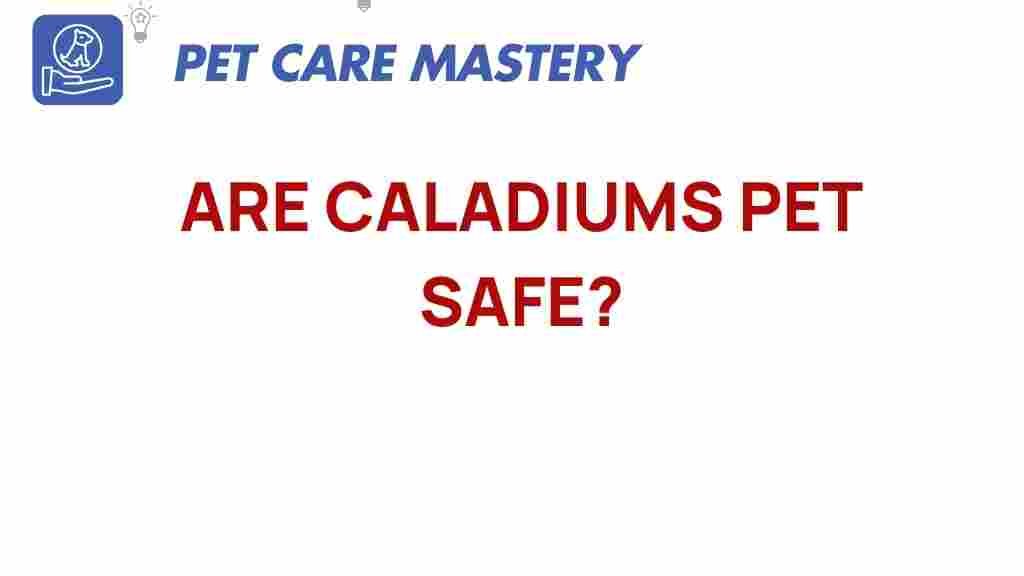Are Caladiums Pet Safe? Discover the Hidden Dangers
Caladiums are beautiful, tropical plants known for their striking foliage and vibrant colors. They are often used as ornamental plants in gardens and homes due to their eye-catching leaves. However, many pet owners wonder: are Caladiums pet safe? This article will explore the hidden dangers associated with Caladiums, particularly if you have furry friends at home.
Understanding Caladiums
Before diving into their safety, it’s essential to understand what Caladiums are. These plants belong to the family Araceae and are native to South America. They thrive in warm, humid environments and are often grown in shady areas. Here are some key points about Caladiums:
- Caladiums are primarily grown for their colorful leaves rather than their flowers.
- They come in various varieties, each with distinct leaf shapes and colors.
- Caladiums prefer indirect sunlight and moist, well-draining soil.
Are Caladiums Toxic to Pets?
To address the question of whether Caladiums are pet safe, we need to consider their toxicity. Unfortunately, the answer is no; Caladiums are toxic to both cats and dogs. They contain calcium oxalate crystals, which can cause various health issues in pets if ingested.
Symptoms of Caladium Poisoning in Pets
If a pet consumes any part of a Caladium plant, they may exhibit several symptoms, including:
- Oral irritation and burning sensations
- Excessive drooling
- Vomiting
- Difficulty swallowing
- Swelling of the mouth and throat
In severe cases, ingestion can lead to more serious health complications, making it crucial to be vigilant if you have Caladiums in your home.
Step-by-Step Guide: What to Do If Your Pet Ingests Caladiums
If you suspect that your pet has ingested Caladiums, follow this step-by-step guide:
- Stay Calm: Your reaction can influence your pet’s stress levels. Remain composed and take immediate action.
- Identify the Symptoms: Monitor your pet for any of the symptoms listed above.
- Remove Access: Ensure that your pet can no longer access the Caladiums.
- Contact Your Veterinarian: Call your vet or an emergency animal clinic for guidance. Provide them with details about the plant and the symptoms your pet is exhibiting.
- Follow Professional Advice: Your veterinarian may recommend bringing your pet in for an examination or suggest home care based on the severity of the situation.
Preventing Caladiums Poisoning
As a responsible pet owner, prevention is always better than cure. Here are some tips to keep your pets safe from Caladiums:
- Placement: Keep Caladiums out of reach, preferably in high places or in rooms where your pets are not allowed.
- Use Pet-Safe Plants: Consider replacing Caladiums with non-toxic plants such as spider plants or Boston ferns.
- Educate Family Members: Ensure everyone in your household, including children, understands the potential dangers of Caladiums.
Alternatives to Caladiums
If you love the look of Caladiums but are concerned about their toxicity to pets, consider these pet-safe alternatives:
- Parlor Palm: A hardy and pet-friendly houseplant that adds a tropical feel.
- Bamboo Palm: Known for its air-purifying qualities and safe for pets.
- Areca Palm: A beautiful, non-toxic plant that thrives in indoor settings.
For more information on pet-safe plants, you can check this guide.
Troubleshooting Tips: Managing Pet Behavior Around Plants
Sometimes, despite our best efforts, pets may still show interest in plants. Here are some tips to manage this behavior:
- Distract with Toys: Provide plenty of toys to keep your pet entertained and distracted from the plants.
- Use Deterrents: Consider using pet-safe deterrent sprays that make plants unappealing to pets.
- Set Boundaries: Train your pets to stay away from specific areas in your home where you keep Caladiums.
Conclusion
In conclusion, while Caladiums are stunning plants that can enhance the beauty of your home, they are not pet safe. Their toxicity can pose serious health risks to both dogs and cats. If you choose to keep Caladiums, it’s essential to take preventive measures to keep your pets safe.
Remember, the well-being of your furry friends should always come first. If you’re uncertain about any plant’s safety, don’t hesitate to consult with your veterinarian or refer to reliable sources online. By being informed, you can enjoy the beauty of plants while ensuring a safe environment for your beloved pets.
For more insights and tips on pet safety and plant care, feel free to explore our other articles here.
This article is in the category Grooming and created by PetCareMastery Team
